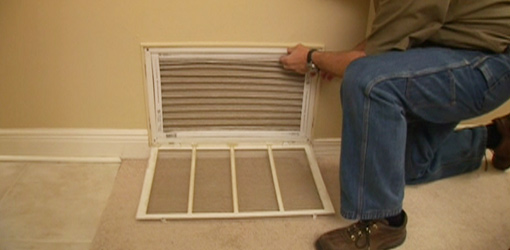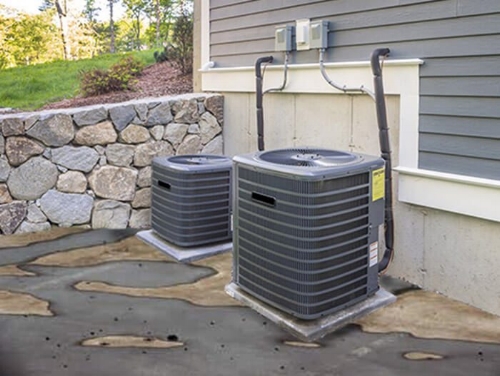Why is my AC leaking water?
Read moreTips for a healthy HVAC system
Tips for a healthy HVAC system
Read moreIs AC maintenance really that important?
Is AC maintenance really that important?
Read moreTroubleshooting 8 Common Air Conditioner Problems
Your filter is dirty. A clogged filter restricts airflow through the unit decreasing its efficiency and reducing the ability to effectively cool the air. If you haven’t cleaned the filter in your room air conditioner recently, do it now. Filters on central AC units should be changed at least once a month, especially if your system is running constantly or you have pets.
Warm air is leaking in. Check the window seals around your unit to make sure hot air isn’t getting in or cold air seeping out. If so, reseal around your unit with pieces of weather stripping.
TV is too close to the AC. Avoid placing lamps or TV sets near the thermostat that controls your central air or near your window unit. The thermostat senses heat from these appliances, which can cause the air conditioner to run longer than necessary.
Registers are dirty or blocked. If you have a forced air heating and cooling system, regularly vacuum the registers to remove any dust buildup. Make sure that furniture and other objects are not blocking the airflow through your registers.
Thermostat is on the wrong setting. If you have a programmable thermostat, make sure you programmed it so your home is at a comfortable temperature when you’re there and a bit higher when you’re not. And keep in mind that for every degree you raise the temperature, you’ll save 3 percent on your air-conditioning costs.
Window units, of course, don’t offer the whole-house control of a central system. If you’re depending on one window unit to cool a large space you’ll have to experiment with the thermostat setting as the temperature will vary depending on where you are in the room.
It’s too sunny inside. If your room AC unit is in a sunny window, it’ll have to work harder to cool your space. Likewise, if the thermostat for your central system is in a sunny spot, it will register the wrong temperature. Your best bet is to keep your shades and curtains drawn all day during the heat of the summer.
Plants are crowding the compressor. The outdoor compressor for central air needs adequate airflow to work correctly, so make sure there’s at least 2 to 3 feet of space between the unit and any plants or structures. There should also be 5 feet of clearance between the top of the unit and any trees above.
You forgot an annual checkup. An inspection by an HVAC technician can catch any serious problems before they get worse and leave you hot and bothered at the peak of summer. A technician will check all the moving parts as well as the refrigerant and recharge the system if necessary.
Contact us today to sign up for our annual maintenance agreement to help keep your system performing at maximum efficiency!
Lighten your load!
You can make your air conditioner work better by reducing the size of the job it has to do. You can do this by improving the building or reducing the internally generated loads that your air conditioner must deal with.
Improving the building “envelope” includes things such as increasing insulation levels or shading windows or reducing air leakage. Such improvements will reduce energy spent on heating and cooling, but may require substantial time or investment. When putting in a new roof or new windows, it is usually cost effective to use high-efficiency products. “Cool” roofing, for example, can save half a ton of cooling and a lot of energy over the year.
Reducing internal loads can be simpler. Shut off unneeded electrical appliances, lights and equipment. Shift appliance use (such as washers and dryers) to cooler times of the day. Use local exhaust fans to remove heat and humidity from kitchens and baths. Buying Energy Star or similarly efficiency appliances helps as well!
How does your AC filter work?
How does your AC filter work?
Read moreWhat does the R-22 refrigerant phase out mean for your HVAC system?
The current phase out of refrigerant in residential and commercial properties leaves home and business owners with unanswered questions. How will this impact the cost of repairs to my HVAC system? Do I need to replace the entire unit? What are my options? The good news is, we’re here to give you some clarification!
The future of refrigerant. Approximately 25 years ago, the U.S. Environmental Protection Agency (EPA) mandated the phase out of R-22 as the result of growing environmental concerns. Acting in accordance of The Clean Air Act, the phase out was enacted to protect the Earth’s ozone layer from the ozone-depleting compound (chlorine) found in R-22. Production of new air conditioning units charged with R-22 ended in 2010, and by 2020 the servicing of R-22-based systems will rely solely on recycled or reclaimed refrigerants.
Alternatives. As R-22 is gradually phased out, alternative refrigerants are being introduced. One of these substitutes is R-410A, a blend of hydrofluorocarbons (HFCs) that does not contribute to depletion of the ozone layer.
Service to current HVAC systems. If your air conditioner was manufactured before 2010, it probably utilizes R-22. The good news – existing units using R-22 can continue to be serviced with R-22 as there is no EPA requirement for change or conversion of these units.
More than likely, your heating and cooling units will have sufficient R-22, unless a leak occurs. Since production is limited, costs to charge existing units leaking R-22 refrigerant have gone up and are expected to rise. The best thing you can do is properly maintain your unit to prevent leaks. You can do so by participating in routine tune-ups in the spring and fall. Routine maintenance is far less expensive than emergency repairs.
Retrofits and substitutions. Retrofit units, converted R-22 units utilizing a substitute refrigerant, are allowed if the alternative has been found acceptable for that type of use. Substitute refrigerants can work well in R-22 units with a few changes to system components. For example, simply replacing R-22 refrigerant with R-410A in a preexisting R-22 unit is not recommended due to its higher working pressure. However, a certified professional can replace R-22 condensers with R-410A condensers, as long as the system coil is also updated. This provides consistency in the refrigerant cycle, as one cannot be replaced without the other, and allows the retrofit to get you by for several more years. Note, the EPA warns of potential safety hazards related to the use of unapproved refrigerants in home air conditioning systems as they are not designed to handle flammable refrigerants.
Impact to the environment. Properly installed home comfort systems rarely develop major refrigerant leaks, and with proper servicing, a system using R-22, R-410A, or another refrigerant will reduce its impact on the environment.
New units. Another important thing a homeowner can do for the environment is to purchase a highly energy-efficient system. Today’s air conditioners use much less energy, provide cost savings in maintenance and electric costs, and offer a green alternative to R-22 units. Rebates and tax credits also help to offset the cost of new systems.
The best time to switch to a new system is before you’re hit by the high costs of repairing a refrigerant system. Take into account the age of your current unit (as a general rule, systems should be older than 10 years); look for the Energy Star® label to save up to 40 percent on utility bills; and consider the minimum seasonal energy efficiency ratio (SEER) specification.
We can help address any concerns you may have about the phase out, as well as help you maintain your HVAC system and assist you in making the right choice for your home or business. Give us a call at 405.243.161 today!
How exactly does your air conditioner work?
The job of your home air conditioner is to move heat from inside your home to the outside, thereby cooling you and your home. Air conditioners blow cool air into your home by pulling the heat out of that air. The air is cooled by blowing it over a set of cold pipes called an evaporator coil. This works just like the cooling that happens when water evaporates from your skin. The evaporator coil is filled with a special liquid called a refrigerant, which changes from a liquid to a gas as it absorbs heat from the air. The refrigerant is pumped outside the house to another coil where it gives up its heat and changes back into a liquid. This outside coil is called the condenser because the refrigerant is condensing from a gas back to a fluid just like moisture on a cold window. A pump, called a compressor, is used to move the refrigerant between the two coils and to change the pressure of the refrigerant so that all the refrigerant evaporates or condenses in the appropriate coils.
The energy to do all of this is used by the motor that runs the compressor. The entire system will normally give about three times the cooling energy that the compressor uses. This odd fact happens because the changing of refrigerant from a liquid to a gas and back again lets the system move much more energy than the compressor uses.
Why is my air conditioner leaking water?
Why is my air conditioner leaking water?
Read moreWhat’s the difference between R-22 and R-410A?
What’s the difference between R-22 and R-410A?
Read moreSteps to a healthy HVAC system
Steps to a healthy HVAC System
Read moreIs AC maintenance really that important?
Is AC maintenance really that important?
Read more





